 |
Real Fuerte de Nuestra Señora La Virgen del Pilar de Zaragoza
...also fortunately known as...
Fort Pilar
Zamboanga City, Philippines
|
|
 |
Built: 1718-1719
Used by: Spain, Republic of Zamboanga,
United States, Japan, Philippines
Conflicts in which it participated: Pirate Bashings, Napoleonic Wars, Second World War
Initially known as: Fort San José
|
In 40AD, James (d. 44AD), one of Jesus (0-33AD)'s twelve disciples, was praying in Zaragossa, Spain when his buddy's mom, the Virgin Mary (19BC-Sometime After 0), miraculously appeared before him. This event was extra-miraculous because it was a rare case of bilocation, in which the sainted person is still alive, and appears somewhere other than where they are presently existing.
1600 years later, Spain and the Pope agreed that Spain owned the Pacific Ocean, and was doing its level best to convert everyone therein to Christianity, while simultaneously and violently exploiting their labor and natural resources. Spain discovered a lush series of islands in 1521, claimed them, named the whole bunch for either King Philip I (1478-1506) or perhaps Philip II (1527-1598), and started colonizing in earnest in 1565. By 1571 Manila was the capital of the Spanish East Indies, which consisted of the Philippines and all the little Pacific islands heading west about a thousand miles. |
 |
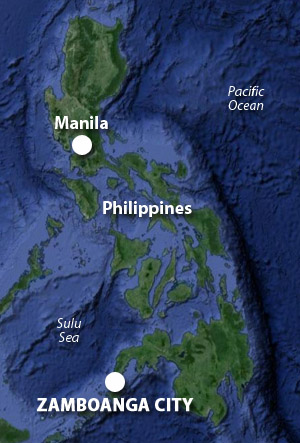
|
|
Surprisingly, there were segments of the many cultures of the Philippines that did not accept Spanish domination. The Sultans of Mindanao and Jolo were particularly uncooperative, preferring their own rule (and religion, which was Islam) to that of the Spanish. The Spanish Governor directed that a stone fort be built at the southern extremity of the Philippines to protect Spanish interests from the frequent raids they were experiencing from the recalictrant Sultans, and the Real Fuerte de San José was established there in 1635. The settlement that sprung up around the fort became Zamboanga City: The area had previously been known as Samboangan, which meant either "place of flowers," "mooring place," "pot" or "bowl." Whatever it meant, it was hispanicized to Zamboanga.
|
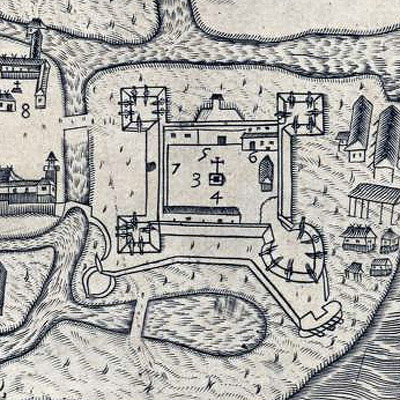 Detail of the starfort of our current interest, from a lovely 1734 map of the Philippines that also includes closeups of the fortifications of Manila and Cavite, click the image to see the whole map! Detail of the starfort of our current interest, from a lovely 1734 map of the Philippines that also includes closeups of the fortifications of Manila and Cavite, click the image to see the whole map! |
 |
Also part of Spain's Pacific dominion were Central- and South America: Peruvian and Mexican laborers were shipped in to assist the Filipinos who had been roped into building the new fort.
The Dutch, who had been fighting Spain for their independence since 1566, were not onboard with the whole Spain-owns-the-Pacific-Ocean thing. They attacked the Real Fuerte de San José in 1646, but were unable to capture it. Had the Dutch waited another sixteen years they could have just walked right into the fort unopposed, as an existential threat from Chinese pirate/general Koxinga (1624-1662) forced the Spanish to withdraw all their troops to Manila, leaving el fuerte in the hands of some Jesuit priests who probably wouldn't have put up much of a fight.
Those priests may or may not have fought when raiders attacked the un-Spanish-defended fort in 1669, but they did have the werewithal to repair the fort, which suffered some understandable damage in the fracas. |
|
|
The Spanish had returned by 1718, clutching plans for a new fort, as well as a new name...and here's where it's revealed why I began this page by yakking about the Virgin Mary! The upgraded fort would be called the Real Fuerte de Nuestra Señora La Virgen del Pilar de Zaragoza, the Royal Fortress of Our Sacred Lady Virgin of the Pillar of Zaragossa, which of course harkened back to that fabbo semi-imaginary event of 40AD. The lovely new starfort proved itself by repelling an attack by 3,000 screaming Moro pirates in 1720.
The Pillar Lady finally got around to visiting this fort that had been so graciously named after her in 1734. On December 6 of that year, the Virgin Mary reportedly approached the city's main gate, where the soldier assigned thereto ordered her to stop. Upon recognizing his local starfort's namesake, however, he fell to his knees...which is the end of the story. What happened then?! History is silent as to the conversation that Virgin Mary and Soldier On His Knees might have had. Recognizing that the Real Fuerte had been legitimately blessed by none other, a relief of the aforementioned Lady, on a pillar, was set above the fort's eastern wall.
|
Which brings us to the pillar. Pillar Lady is represented in paintings and statues in several locations in Europe, South America and the Philippines. Why is Mary, in this case, the Lady of the Pillar? Votive images of Mary were left on pillars, as offerings to God, as early as the 4th century AD. What differentiates Mary the Lady of the Pillar from the good, old-fashioned Virgin Mary? Nothing, and probably everything, but this is making my brain hurt so let's move on.
Zamboanga was purposefully populated with a deportation of vagrants from Manila, under the assumption that any warm body would be a defensive entity in the event of a pirate attack. The feisty townsfolk of Zamboanga did prove useful in the defense of Fort Pilar, but not until 1798.
For 'twas in that year that Spain and her colonies, having recently changed sides in the Napoleonic Wars (1803-1815), became of intense interest to the Royal Navy. A British expedition led by Captain Edward Cooke (1772-1799) sailed into Manila Bay to determine the ability of Spain's navy to interfere with Britain's lucrative China Fleet. |
 |
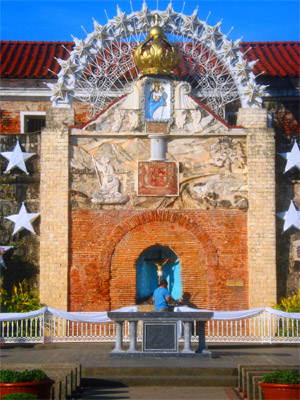 The Lady of the Pillar's shrine at Fort Pilar. The Lady of the Pillar's shrine at Fort Pilar.
And a guy. |
|
Cooke's ships anchored in the harbor and raised the French flag, an acceptable ruse de guerre, which lured several boatloads of official (and gullible) Spaniards out to be captured and interrogated. Satisfied that the Spanish fleet based at Manila was in no shape to do much of anything of an offensive nature, he sailed south to Zamboanga, planning to do harm to Fort Pilar.
The British attempted to continue the ruse and approached Zamboanga's harbor under the Spanish flag on January 22, 1798...but through a series of unfortunate fumblings, managed to alert the garrison to their intentions. Cooke's fleet bombarded Fort Pilar, doing little damage, although at least 450 British roundshot of varied calibers were later recovered in and around the fort. An amphibious landing was attempted, to attack the fort's landward side, but those few British marines who made it ashore were chased back into the sea by 250 lance-armed Zamboangans. Thanks for that timely repopulation scheme, Spanish authorities!
|
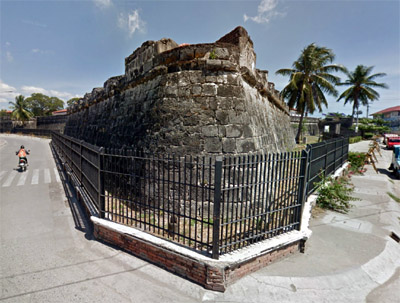 Fort Pilar's southwestern bastion, the big elongated one, today. Honestly, I think that bastion's trying to compensate for something. All hail Google Earth, whence this image came. Fort Pilar's southwestern bastion, the big elongated one, today. Honestly, I think that bastion's trying to compensate for something. All hail Google Earth, whence this image came. |
 |
Like many a starfort, Fort Pilar was utilized by its owners as a prison, once there was no immediate threat requiring its defensive capabilities. A prisoner revolt occurred there in 1872, but it must not have gotten very far, because the fact that it happened is all I can tell you about it.
The Virgin Mary reappeared o'er Zamboanga in 1897. A mighty earthquake was rattling the area, and Mary raised her right hand towards an onrushing tsunami: Tsunami averted, and the city was saved. From the tidal wave at least; no report on what she did about the earthquake.
During the Spanish-American War (1898), Fort Pilar was the last holdout of the last Spanish Governor in the Philippines. |
|
|
Upon the fall of Manila to the United States in December of 1898, Governor Diego de los Ríos (1850-1911) arrived at Fort Pilar, ready to muster his forces to fight the local Filipino revolutionaries, who were led by General Vicente Álvarez (1862-1942). Fierce fighting raged in and around Zamboanga, with Álvarez's force finally besieging Fort Pilar in April of 1899. The US Army sailed two shiploads of soldiers to Zamboanga in early May to take control of Fort Pilar, but neither of those combatants that were already fighting for control of the fort & city wanted the fricking Americans involved, and the invasion ships were driven away by artillery fire from the fort.
Governor Ríos was finally forced to surrender Fort Pilar, and by extension the city, to the Revolutionary Government of Zamboanga on May 18, 1899. The Spanish finally got around to leaving five days later, after burning down as much as the city as possible in a last "eff you" gesture. Based at Fort Pilar, the new Republic of Zamboanga's president was General Álvarez. One of his convictions was that the governent should be inclusive, and his army included Christians, Muslims and Lumads (indigenous locals)...which sounded nice, but while Álvarez was away recruiting troops to fight the oncoming Americans, some of his people opened Fort Pilar's doors to a force of those very Americans. Threachery! Álvarez took to the hills and continued fighting, but was captured and imprisoned by the US Army in 1902.
|
The Republic of Zamboanga was permitted to continue to exist, so long as it remained favorable to the United States. This lasted until 1903, when it was determined that the Republic was not adequately controlling its people, and the American colonial government instituted the new Moro Province, with Zamboanga as its capital city.
One of several new American infantry units that were established to fight in the Philippine American War (1899-1902) was the 27th Infantry Regiment, the Wolfhounds. Their official march song, even to this day, is "The Monkeys Have no Tails in Zamboanga."
Oh, the monkeys have no tails in Zamboanga.
Oh, the monkeys have no tails in Zamboanga.
Oh, the monkeys have no tails,They were bitten off by whales,
Oh, the monkeys have no tails in Zamboanga. |
 |
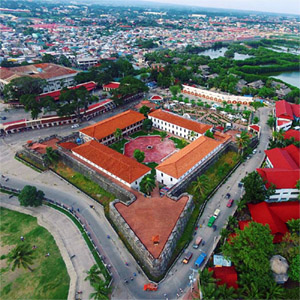 Fort Pilar in 2015. Fort Pilar in 2015. |
|
"Monkeys" in this case refers to the prostitutes of Zamboanga, with whom the 27th Infantry Regiment were obviously intimately familiar...and while it's pretty disrespectful to refer to any humans as monkeys, these were prostitutes, and they were probably already well accustomed to disrespect in general, and racial slurs in particular.
The Second World War (1939-1945) brought the Japanese to the Philippines, and Zamboanga was captured in March of 1942. One of Imperial Japan's claims at the outset of the war was that it intended for Asia to be for Asians; that every figment of European colonialism should be expunged. This sounded swell in the abstract to a lot of Asians, but any Zamboangans who had high hopes for an immediate post-colonial utopia got a shock when Zamboanga was made a branch hub of Unit 731.
|
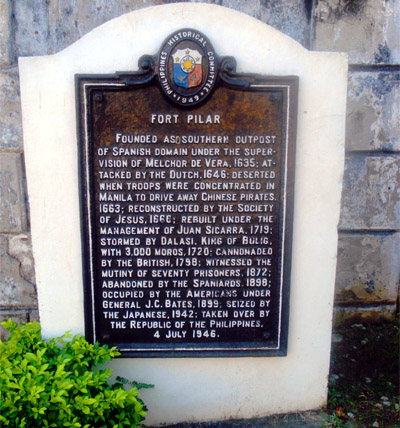 I've done it to you again, I've made you wade all the way through my tortured prose to learn the history of Fort Pilar, when all I really had to do was post this picture of this sign on the internet, and direct your attention to it. You're welcome! I've done it to you again, I've made you wade all the way through my tortured prose to learn the history of Fort Pilar, when all I really had to do was post this picture of this sign on the internet, and direct your attention to it. You're welcome! |
 |
A Japanese program for the development of biologcal and chemical weapons, Unit 731 committed many of the worst war crimes of this already-quite-inhumane conflict, and many Filipinos were cruelly and unnecessarily "operated upon" by the Japanese. Fortunately, Filipino and American forces recaptured Zamboanga in March of 1945, and the city was officially handed over to the Republic of the Philippines on July 4, 1946.
Fort Pilar left to rot after the war, but was recognized to be a National Cultural Treasure in 1973. Restoration work began in 1980, and by 1987 the fort had been opened to the public with a permanent exhibition representing sea life of the region.
Today Fort Pilar is mostly known as a shrine to the Virgin Mary! Copious outdoor seating has been built next to the fort, and masses are regularly held there. Fear not, you can buy your rosaries, souvenirs and the most important candles just outside the gate! |
|
|
|
|
|
|
|
 |




